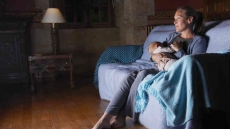To personalize the decor of this Mount Pleasant, S.C. home, interior designer Elizabeth Stuart created a gallery wall of family portraits along a stairway wall, shown here in this undated photo. (Katie Fiedler/Katie Charlotte Photography/Elizabeth Stuart via AP)
When your entire life is happening inside your home, it matters how that space feels and functions.
Interior designers often focused on this even before self-quarantine, asking clients how they spend their time at home and how various rooms might make them happier. These questions get at the real purpose of a well-designed home.
And now they seem more important than ever.
“We’re expecting more from our homes than we ever have before, and they can serve us in more ways than we’ve asked in the past,’’ says New York-based interior designer Carolyn DiCarlo. ``We’ve historically looked to trends or magazines to tell us what to put in our homes. But now is a different time. It’s time to consider our home as our personal place of refuge, and how to make that happen.”
Here, DiCarlo and two other interior designers — New York-based Jenny Dina Kirschner and South Carolina-based Elizabeth Stuart — share advice on how they create homes that make clients’ lives better.
These changes don’t have to be complicated or expensive. They just involve asking the right questions.
First: What do you see when you walk in the door?
Entering our homes after a trip to a store has become newly stressful, but it’s always been important, says Stuart. Improving the first 4 feet of space when you walk in, Stuart says, can improve the way you feel at home.
Especially if you enter through a garage or mudroom, she says, make sure “that first thing you have when you come home is not chaos.”
Consider creating a neater, cleaner entryway with a bench or chair where you can remove shoes (and use hand sanitizer); dedicated spots for items like keys; appealing lighting; and perhaps a diffuser with a calming fragrance. You can even add easy access to something comforting, like a cold drink.
Plan these spaces with your temperament and wellness in mind, DiCarlo says. For example, those prone to depression might benefit from adding warmer colours.
Next, DiCarlo encourages people to walk through each room of their home and notice: Does it feel unwelcoming or disorganized? Which rooms reflect who you are, or aim to be, and which don’t?
“I look to see where their lack of ease is,” DiCarlo explains. “That’s sort of the meat of how you get into this exploration.”
Kirschner recommends a similar approach, and says it often leads clients to realize they want more organization or a less sterile, more welcoming home. Gray is a popular colour in decor, but a room decorated mainly in stylish gray and white can feel dreary or cold. If so, add bright colours by ordering a few new items or bringing in bright pieces from other rooms.
And when it becomes possible to renovate again, consider adding or changing windows. Kirschner had a client who wanted a more open and airy home. “She had a duplex, so we cut a hole out of the ceiling over the living room to get double height,” and added glass panels along one wall, Kirschner says.
Rearranging your furniture to maximize how much light you get at different times of day can be an easy fix, DiCarlo says.
Also consider: Does your home have a centre?
While writing a book about using a home to improve wellness and happiness, DiCarlo has been researching sacred spaces. These spaces always have a fixed centre from which to gain orientation, she says, and activity flows in and out of that centre.
Your “centre” doesn’t have to be the literal middle of your home, she says. It could be a welcoming kitchen at the back. But note the flow of activity and energy in and out of it, and perhaps improve it with things like soothing music and healthy green plants.
What about your stuff? Kirschner says clutter adds low-level stress to many homes, yet people tolerate it because they’re busy and aren’t sure how to address it.
“People have a very hard time with organization,” she says.
During self-quarantine, clutter may cause even more stress, so consider eliminating unwanted items and creating better storage systems for what remains, Kirschner says. On the flip side, Stuart says, consider whether some items should come out of storage. Do you have a collection of things that would bring you joy if you put it where you’d see it every day?
Another question: Is your bedside table too small? Make sure you have enough space for a book, water glass or whatever you want handy.
Last: Where do you do the things that bring you happiness?
Think about where you like to sit — or where you would sit if you had the right chair, says Stuart. Coffee-lovers can create a cozier place to drink their morning coffee, while book lovers could choose exactly the right chair and ottoman, and place them near the right lamp or window. Whether you love knitting or taking long baths, DiCarlo says, make a space for your favourite thing — even if it’s a tiny area — and enjoy it.
You’re “actually making a place not just for refuge,” she says, “but for ritual.”
___
EDITOR’S NOTE - Melissa Rayworth writes lifestyles stories for The Associated Press. Follow her on Twitter at @mrayworth.





